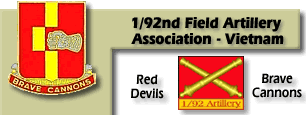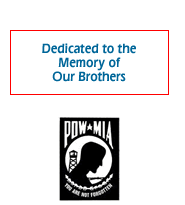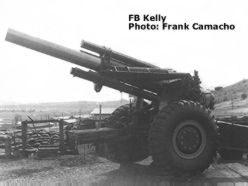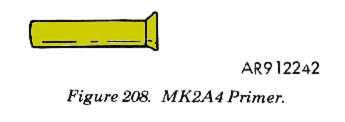 |
|
 |
|
The 1/92nd Field
Artillery
Association - Vietnam

Munitions
| Projectiles | Fuzes | Wrenches & Setters |
| Powders | Primer |
|
The 1/92nd Field
Artillery |
|
||||
|
||||||
|
||||||
|
The Projectiles The projectiles of the 155mm Howitzer went by many names; shells, projos, rounds, and joes to name a few. Just as there were many names, so there were several different types of projectiles to accomplish the many missions the gun was expected to perform. Add several different fuzes, and two different powders, and the 155 became a very versatile weapon.
To mark where the explosive rounds would hit, or to indicate to a unit in the field where they were, the M116(A1) Colored Smoke/High Cloud round was used. The smoke was bright red, purple, or yellow. The high cloud round was white smoke, but could be used as a marker at night as it left a stream of sparks going into the target. All of the smoke rounds used mechanical time fuzes. The White Phosphorus (WP), M110, was also used as a marker round. It could be fitted with PD, VT, and MT fuzes. When the situation called for it, white phosphorus became a devastating weapon against personnel. The thick white smoke could be used as a screen to mask movement by troops in the field. Illumination was a very important mission for artillery in Vietnam. To accomplish that, the 155mm howitzer used the M485(A1). Each round was capable of lighting up a 1000 yard diameter area. The flare was ejected at 700 yards altitude, and would stay lit for at least 90 seconds. By keeping two flares in the air at a time, shadows were reduced. At a firing rate of two rounds a minute, an area could be kept lit all night long. The ICM (Improved Conventional Weapons), or Firecracker round (M449) was used for antipersonnel missions. An airburst, base ejecting shell, it dropped sixty bomblets that bounced up five feet in the air before going off. It proved to be extremely effective against enemy in the open, or in positions with little, or no overhead protection. We have included the gas round, M121A1 although it is not clear that the 1/92nd ever fired it in anger. Delivered as an airburst, or as a point detonating round, it contained Ca, or Cs types of "tear" gas.
* The M485 was to be fired at a maximum charge 6, while the M485A1 could be fired at Charge 7.
|
Fuze/Projectile Combinations
|
Fuze
|
Type
|
Uses
|
Projectiles
|
|
M557/M739
|
SQPD/Delay
|
Impact/Subsurface
|
HE,WP,Gas
|
|
M564
|
MT/SQ
|
Airburst/Impact
|
HE,WP,Gas
|
|
M565
|
MT
|
Airburst
|
Illumination, M449
|
|
M501(A1)
|
MT/SQ
|
Airburst/Impact
|
High
Cloud/Smoke
|
|
M729
|
Proximity/SQ
|
Airburst/Impact
|
HE,
WP, Gas
|
|
M78(A1)
|
CP/Delay
|
Concrete
|
HE,
WP, Gas
|
 |
The M63 fuze setter consisted of a handle, and socket assembly. The "T" wrench handle contained a slip cluch assembley which engages the socket to the fuze when turned in a clockwise rotation, and sets the time. The socket will click, and slip when the proper time is set. It will also slip when turned in a counter-clockwise manner. A light illuminates the scale on the fuze when activated by pushing a button on the handle. The M63 handle, and socket are stored in the M178 case. |
 |
The MK2A4 primer is the only authorized primer for use in the M1, M1A1, or M1A2 tubes. The primers are ready for use when unpackaged. |